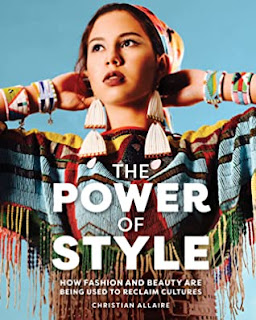I sat enthralled as I watched the whole Biden Inauguration on January 20, 2021. Every moment was a revelation, a joy, a weight lifted from my shoulders, a time of great happiness. But no moment was more poignant or wistful than when Amanda Gorman the National Youth Poet Laureate and youngest poet to ever participate an inauguration, stepped up and recited "
The Hill We Climb." Gorman stole the show that day. Afterwards she confessed she completed the poem the day after watching the January 6th insurrection attempt on the Capitol. Reread the poem (
here) and it takes on a whole new meaning knowing this:
We've seen a force that would shatter our nation rather than share it,
Would destroy our country if it meant delaying democracy.
And this effort very nearly succeeded.
But while democracy can be periodically delayed,
It can never be permanently defeated. /
Days after the inauguration, I ran to the library to check out whatever books I could by Amanda Gorman and discovered that she wasn't published yet. I placed a hold on the small book of her inauguration poem, The Hill We Climb, which was being rushed into publication, and for her upcoming collection, this book, Call Us What We Carry: Poems, which would be published late in 2021. I finally got my turn with the poetry almost a year to the day from inauguration day.
The book jacket says that this book is a message in a bottle, a letter, and it does not let up. "It captures a shipwrecked moment in time and transforms it into a lyric of hope and healing." Using a variety of poetic styles, including a powerful section of erasure poems, it explores history, language, identity and our collective grief during a global pandemic. In a time period when some parents are concerned that their children not learn anything negative about our history, Gorman holds up a mirror and asks us to look within. We may not always like what we see or learn, but it is real and it is important for us to know and to remember.
Call Us What We Carry is possibly the most difficult poetry collection I've ever read. Not difficult in terms of language but difficult in terms of content. Not only is the collection full of poems about what it was like living through the pandemic but about slavery, and race relations, and being "other."
The first section is titled Requiem. In the poem "At First" Gorman writes about our collective experiences with the pandemic: "March shuddered into a year. / Sloshing with millions of lonely, / An overcrowded solitude." I laughed at the turn of phrase in the poem, "There's No Power Like Home": "We were sick of home. / Home sick. / That mask around our ear / Hung itself into the year. / Once we stepped into our home, / We found ourselves gasping, tearing it off like a bandage." Didn't you feel sick and tired of being stuck at home, yet when you went out, didn't you hate the way it felt wearing a mask? I have certainly flung off my mask the second I've returned to my car or home. Clearly in years to come people will read the poems in this collection if they are curious how we coped with our new, restricted lives.
The next section, What a Piece of Wreck is Man, many of the poems relate to shipping, boats, water, drowning. "In the Deep" our pandemic experiences were likened to being on a ship bucking at sea. "For a year our television / Was a lighthouse, blinking / Only in warning & never in warmth. / ... / Grief made ropes of our arms. / This whole time, what we craved most / Was only all that we have ever loved." My husband and I had each other and we included our daughter and her family in our bubble. So I never felt that desperate feeling that comes from no human contact. But I know many who did experience that deep loneliness.
Portions of Call Us What We Carry reads very much like a history lesson. In the poem "Vale of the Shadow of Death or Extra! Extra! Read All About It" Gorman uses primary documents to report, in poetic form, about the Spanish flu, The Chinese Exclusion Act, and other documents that blame that deadly flu on Blacks and Asian people. Sound familiar? In the section titled Atonement, she uses erasure poems using primary documents, letters, and diary entries to make poignant points about people who have been ignored throughout our history. Gorman says she wants these erasure poems to create an extension instead of an extract. "Hereby the pen looks to enhance, evoke, explore, expose the bodies, the truth, the voices that have always existed but have been exiled from history & the imagination. In this case, we erase to find." These poems were very powerful but were quite difficult to read and to digest.
I suspect I will need to reread this volume of poems several times to really gain a fuller appreciation for all the poems. My favorite poem, after the inaugural one I referenced above, was the "Call Us What We Carry" which was used as the title for the book. In it we are reminded that there is joy in the world and we should discard those things from our life like rage, wreckage, hubris, hate, ghosts, greed, wrath, and wars. "...Rejoice for / What we have left / Behind will not free us. / But what we have left / Is all we need. / We are enough / ...We walk into tomorrow. / Carrying nothing. / But the world."
-Anne


































